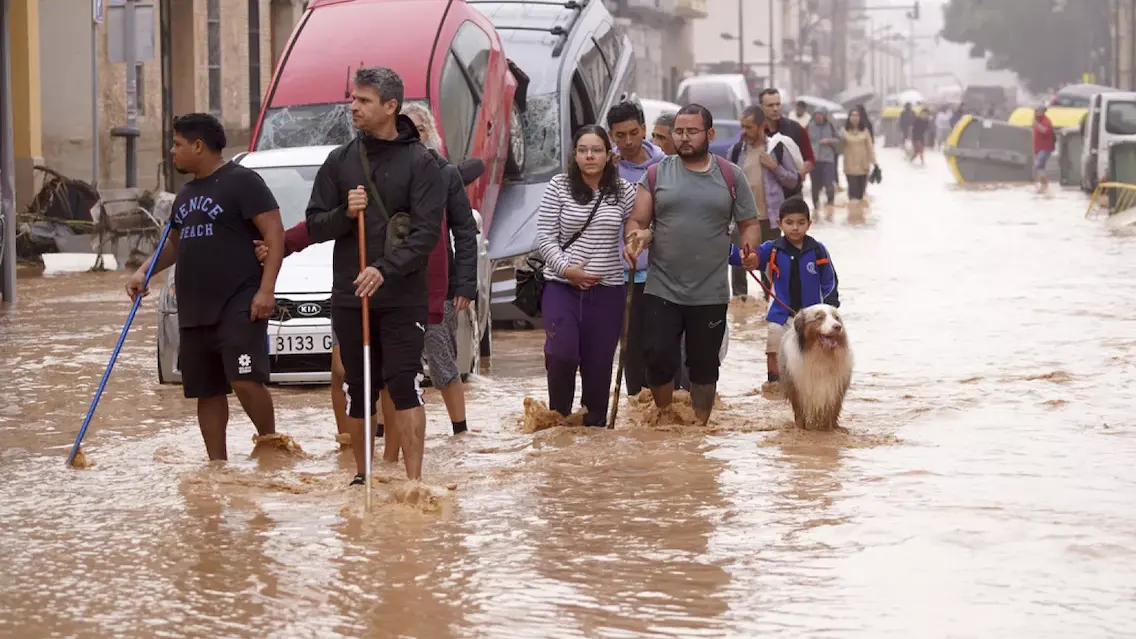
Spain is reeling from extreme weather as flash floods devastate cities and heatwaves claim over 1,180 lives
1. Torrential Floods: Cities Underwater, Lives at Risk
Spain Climate Crisis – Spain’s northeastern regions, including Catalonia, Aragon, and Valencia, have been battered by torrential rains and flash floods, leaving two people missing and prompting emergency alerts across 25 provinces.
- In Cubelles, a woman and young girl were swept away by the Foix River while crossing a footbridge.
- The Ebro riverbank in Zaragoza saw 100mm of rainfall in just one hour, triggering red alerts and widespread panic.
- Renfe, Spain’s national rail company, suspended operations in Catalonia due to submerged tracks and damaged infrastructure.
Table of Contents
The floods are linked to a weather phenomenon known as DANA (Isolated Depression at High Levels), where cold air masses collide with warm Mediterranean waters, unleashing violent storms. Streets turned into rivers, cars were swept away, and hospitals were forced to close due to flooding.
Spain’s Military Emergency Unit (UME) was deployed to assist with evacuations and rescue operations, highlighting the scale of the disaster.
2. Heatwaves Turn Deadly: Over 1180 Lives Lost
While the north drowns, the south burns. Spain has recorded 1180 heat-related deaths between May 16 and July 13, a staggering rise from 114 deaths during the same period last year.
- Temperatures soared past 40°C in regions like Andalusia, Galicia, and La Rioja, traditionally cooler areas now facing unprecedented heat.
- The majority of victims were elderly women, underscoring the vulnerability of aging populations to climate extremes.
- 76 red alerts for extreme heat were issued in just two months, compared to none in 2024.
The heatwave has also sparked wildfires, with over 21,000 hectares burned this year. In Mijas, a blaze near a tourist hotspot was brought under control after threatening homes and golf resorts.
Experts warn that marine heatwaves in the Mediterranean are compounding the crisis, with sea temperatures matching August records as early as June.
3. Climate Change: The Invisible Hand Behind the Chaos
Spain’s climate volatility is no longer a seasonal anomaly, it’s a symptom of a deeper crisis. According to the World Meteorological Organization (WMO) and IPCC, rising global temperatures are accelerating the hydrological cycle, making floods and heatwaves more intense and frequent.
- DANA events are becoming more destructive due to warmer sea surfaces and increased atmospheric moisture.
- Heatwaves are now striking earlier and harder, with June 2025 being Spain’s hottest since records began.
- The Carlos III Health Institute attributes the surge in mortality to “an unprecedented increase in average temperatures”.
This “weather whiplash”—oscillating between droughts and deluges, is a textbook case of climate instability. Urban infrastructure, healthcare systems, and emergency services are struggling to keep pace.
4. Building Resilience: What Spain Must Do Next
Spain’s climate crisis demands urgent action across multiple fronts:
| Challenge | Impact | Recommended Response |
| Flash Floods | Infrastructure damage, missing persons | Invest in flood-resistant urban planning |
| Heatwave Mortality | 1,180 deaths in 2 months | Expand cooling centers, public awareness |
| Wildfires | 21,000+ hectares burned | Boost firefighting capacity, reforestation |
| Aging Population | High vulnerability | Targeted health interventions |
| Climate Adaptation | Lagging investment | Accelerate green infrastructure funding |
The Global Commission on Adaptation estimates that a $1.8 trillion investment in climate resilience could yield $7.1 trillion in avoided costs and benefits. Spain must prioritize:
- Early warning systems for extreme weather
- Climate-resilient housing and transport
- Public education campaigns on heat safety
- International collaboration on emissions and adaptation
Final Thoughts: A Nation at a Crossroads
Spain’s battle with floods and heatwaves is more than a meteorological anomaly, it’s a climate reckoning. The loss of life, economic disruption, and ecological damage are stark reminders that the cost of inaction is unbearable.
As the Mediterranean warms and weather patterns grow erratic, Spain must lead by example, investing in resilience, protecting its most vulnerable, and pushing for global climate accountability.
Rapidoupdates.com will continue to track this evolving crisis, because in the age of climate change, every storm tells a story and every degree matters.
FAQ
What caused the recent floods in Spain?
The floods were triggered by a weather phenomenon known as DANA (Isolated Depression at High Levels), where cold air masses collide with warm Mediterranean waters, resulting in torrential rain and flash flooding.
How severe are the heatwaves in Spain this year?
Between May 16 and July 13, 2025, Spain recorded 1,180 heat-related deaths, a dramatic rise from 114 deaths during the same period in 2024. Temperatures have frequently exceeded 40°C, even in traditionally cooler regions like Galicia and La Rioja.
Which regions are most affected by the floods and heatwaves?
Floods have hit Catalonia, Aragon, Valencia, and Zaragoza, while heatwaves have impacted Andalusia, Galicia, Asturias, and Cantabria. Over 25 provinces were placed under weather alerts, with eight under orange alert for severe storms.
Is climate change responsible for these extreme weather events?
Yes. Experts from the World Meteorological Organization (WMO) and IPCC confirm that rising global temperatures are accelerating the hydrological cycle, making floods and heatwaves more frequent and intense.
Who is most vulnerable to heat-related deaths in Spain?
The majority of victims are elderly women over 65, especially in areas lacking adequate cooling infrastructure or access to healthcare.
Stay updated with the latest news on Rapido Updates. Keep yourself updated with The World, India News, Entertainment, Market, Automobile, Gadgets, Sports, and many more